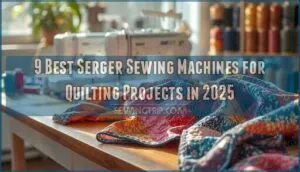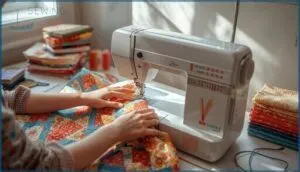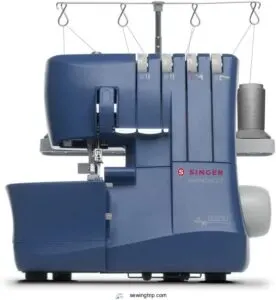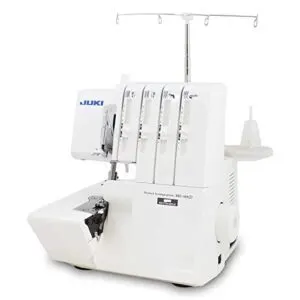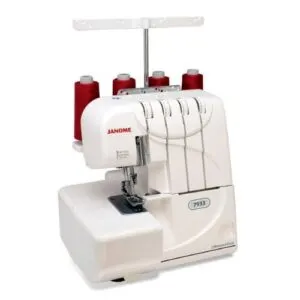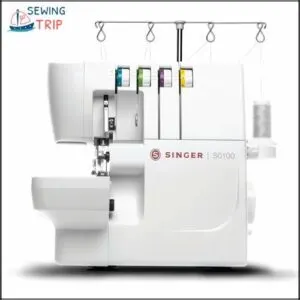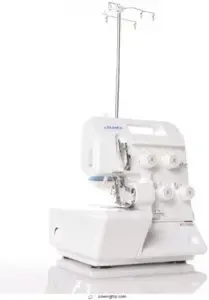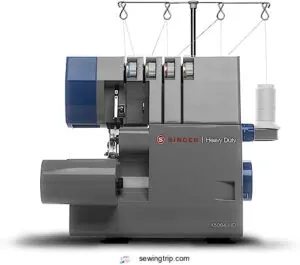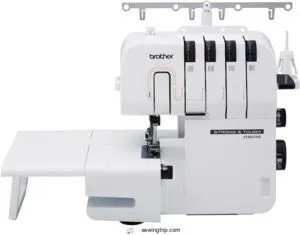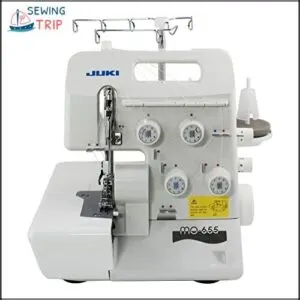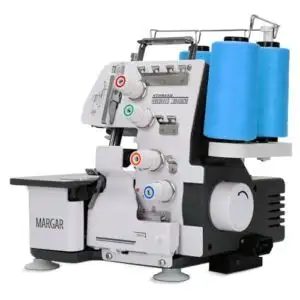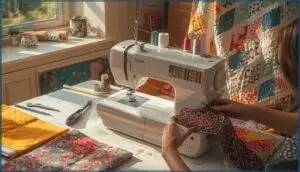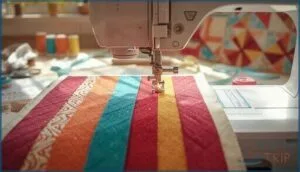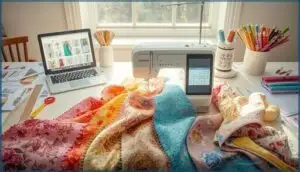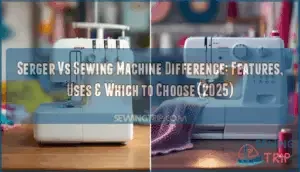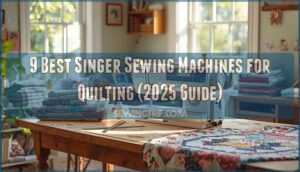This site is supported by our readers. We may earn a commission, at no cost to you, if you purchase through links.
Your first serger seam can feel like a leap of faith—threads flying everywhere, fabric zooming through at lightning speed, and that distinctive whirring sound that either thrills or terrifies you. But here’s the truth: quilters who master a serger cut their piecing time in half while creating seams that won’t budge, even after countless washes.
Traditional sewing machines excel at topstitching and precision work, yet they can’t match a serger’s ability to finish edges, prevent fraying, and handle multiple layers of batting with ease. The right serger sewing machine for quilting projects transforms how you approach everything from basic quilt blocks to elaborate art quilts.
Whether you’re tackling a queen-sized quilt-as-you-go project or adding professional decorative edges to your handmade gifts, choosing a serger with the right stitch options, differential feed, and threading system makes all the difference between frustration and creative flow.
Table Of Contents
- Key Takeaways
- Key Serger Features for Quilting Projects
- Essential Serger Techniques for Quilters
- Top 9 Sergers for Quilting Projects
- 1. Singer Heavy Duty Serger Overlock Machine
- 2. Juki MO-114D Overlock Sewing Machine
- 3. Janome 7933 Horizon Differential Feed Serger
- 4. Singer S0100 Serger Overlock Machine Kit
- 5. Juki MO644D Portable Home Serger
- 6. Singer Heavy Duty Metal Frame Serger
- 7. Brother Strong Tough Heavy Duty Serger
- 8. Juki MO-655 Pearl Finish Serger
- 9. Pro Serger Heavy Duty Sewing Machine
- Choosing The Right Serger for Your Needs
- Creative Quilting Projects With a Serger
- Frequently Asked Questions (FAQs)
- Conclusion
Key Takeaways
- Sergers cut quilting time in half by finishing edges and preventing fraying in one pass, but they complement rather than replace traditional sewing machines since they can’t handle topstitching or precision work.
- The four must-have serger features for quilting success are differential feed for fabric control, adjustable stitch length for seam strength, easy threading systems to reduce frustration, and 4-thread overlock capability for maximum durability.
- Mastering three core techniques—piecing blocks with consistent quarter-inch seams, joining batting with flatlock stitches, and creating decorative edges—unlocks professional results that survive 200+ wash cycles.
- Budget-friendly sergers under $250 deliver solid performance for beginners, while mid-range models ($400–$800) offer the best value by balancing ease of use with durability and advanced features like adjustable differential feed.
Key Serger Features for Quilting Projects
Not all sergers are created equal, especially when you’re piecing intricate quilt blocks or finishing miles of seam allowances. The right features can mean the difference between a frustrating afternoon and smooth sailing through your quilting projects.
Let’s look at the essential features that’ll help you choose a serger that matches your quilting ambitions.
Stitch Options and Thread Capacity
Most sergers offer 2 to 5 stitch types, giving you excellent decorative options and stitch durability. The 4-thread overlock delivers the strongest seams, while flatlock creates beautiful ladder-like textures.
Thread weight matters—50-weight serger thread provides excellent smoothness at high speeds. To minimize issues, consider polyester thread options for less lint.
Four-thread stitches consume about 18 cm of thread per cm of seam, so consumption rates add up fast on larger quilts.
Differential Feed and Stitch Length Adjustment
If you want perfect seams and smooth piecing, mastering Fabric Feed Control and Stitch Density Effects is key. Adjusting Differential Feed lets you tackle bias edge solutions, prevent stretching, or add decorative gathering. Understanding how to use differential feed settings is vital for professional serging. Stitch Length tweaks boost seam durability and flatten seams beautifully.
Here’s what to watch:
- Control bias stretch and gathering
- Fine-tune stitch density
- Improve seam strength
Speed, Power, and Heavy-Duty Performance
Once you’ve dialed in your stitch length, it’s time to let speed and power shine. HighSpeed Performance—like 1,300 to 1,700 stitches per minute—means you’ll zip through thick fabric layers.
HeavyDuty sergers with solid Frame Durability and strong Motor Wattage tackle tough quilts easily. Machines like the Baby Lock Victory balance Energy Efficiency with muscle, so every seam stays consistent.
Ease of Threading and Tension Controls
After powering through thick seams, nothing slows you down like tricky threading. Easy Threading features—like air threading and color-coded paths—slash threading errors and cut the learning curve.
Tension adjustability is your secret weapon for handling fabric variations. Thread management matters: balanced thread tension keeps stitches tidy.
Choosing a Quilting Serger with these upgrades means less fuss, more fun.
Portability and Machine Weight
How often do you move your serger around the house or to classes? Portability features make all the difference for quilting on the go. Lightweight models—like those under 16 pounds—offer:
- Ergonomic design for easy lifting
- Compact storage solutions for tight spaces
- Transport methods like padded bags and carry grips
Choosing a serger with these perks means less hassle, more creative freedom.
Accessories for Quilting Versatility
With serger accessories and attachments, your quilting options explode. Specialty feet and accessory kits let you add piping, gather fabric, or master perfect seams. Versatility uses range from decorative edges to flatlock joining. Brand compatibility is easy thanks to universal snap-on systems. The economic impact is clear—quilters invest in these serger features for quilting efficiency and creative freedom.
| Specialty Feet | Versatility Uses |
|---|---|
| Blind-hem foot | Decorative hems |
| 1/4 inch seam foot | Patchwork precision |
| Gatherer foot | Ruffles, home décor |
Essential Serger Techniques for Quilters
Using a serger opens up a whole new world of quilting possibilities. There are some key techniques that make your projects faster, neater, and more creative.
Let’s look at the essential ways you can put your serger to work in quilting.
Piecing Quilt Blocks With a Serger
Ever wondered how piecing quilt blocks with a serger can greatly improve your quilting projects? You’ll love the speed and tidy results. With sergers for quilting, you get:
- Consistent quarter-inch seam accuracy
- Assembly efficiency—up to three times faster
- Reduced thread consumption
- Minimal bulk behavior for flat blocks
Perfect for practical applications and adventurous quilt designs!
Serging Quilt Edges and Finishing Seams
Did you know serging quilt edges can cut fraying by 85% and save you nearly half your finishing time? You’ll get flatter seams, stronger edges, and cleaner results—perfect for quilting that lasts.
Here’s how serger techniques stack up:
| Edge Fray Prevention | Seam Durability | Bulk Reduction |
|---|---|---|
| 85% less fray | 30% stronger | 80% trimmed |
| Time Savings | Decorative Finishes | Cleaner Binding |
| 50% faster | Creative threads | 25% less slippage |
Joining Batting and Backing With Flatlock Seams
Want seams that disappear into your quilt? Flatlock stitch is your secret weapon for joining batting and piecing quilt backs.
With smart tension adjustment and the right thread types, you’ll get flat, durable seams that boost fabric compatibility. A 2–4mm stitch length keeps bulk down, and your serger’s flatlock delivers strength and stability—no more puckering or rippling!
Creating Decorative Stitches and Trims
Ready to make your quilt pop with texture and color? Dive into decorative stitching—where specialty threads meet creative trims. With precise tension adjustments, you can master ruffle techniques, lace application, and cording creation. Your serger transforms quilting from practical to artful, letting decorative thread shine in every seam.
- Rolled hems with metallic thread
- Flatlock lace borders
- Ruffled edges
- Cording for bold accents
Making Piping and Inserting Zippers
After adding decorative trims, let’s talk about piping and zipper finishes—two details that can truly enhance your quilting. With piping feet, your serger wraps and secures cording in one pass. Differential feed keeps edges smooth, while fabric stabilization stops puckering.
For zippers, you’ll get clean, strong seams that hold up beautifully, especially on stretchy or layered quilts.
Top 9 Sergers for Quilting Projects
If you’re ready to pick the perfect serger for your quilting adventures, you’re in the right place. Each machine here offers something special for creative quilters.
Let’s take a closer look at the top choices for 2025.
1. Singer Heavy Duty Serger Overlock Machine
If you’re chasing speed and precision, the Singer Heavy Duty Serger Overlock Machine stands out among Top Sergers for Quilting. Its Heavy-Duty Build and larger cutting knife slice through thick layers with ease, while the Threading System and adjustable stitch controls make setup a breeze.
You’ll appreciate the Quilting Versatility—tackle rolled hems, flatlocks, and overlocks with confidence. Whether you’re piecing blocks or finishing edges, the Stitch Performance delivers consistent results.
For practical User Benefits, it’s hard to beat the Singer S0230 Serger and Singer X5005HD.
Best For: Quilters and sewists who want a fast, durable serger that handles thick fabrics and offers versatile stitch options.
- Handles heavy quilting fabrics and multiple layers with ease
- Fast stitching speed (up to 1,300 stitches per minute) saves time
- Color-coded threading and adjustable controls make setup simple
- Threading can be messy and lacks a trim trap
- No instruction manual included, which may frustrate beginners
- Some users report issues with out-of-the-box performance
2. Juki MO-114D Overlock Sewing Machine
If you’re looking for power and control, the Juki MO114D Serger is a top contender in sergers for quilting. Its Threading System and Differential Feed make setup and fabric handling simple—even for thick quilt layers.
With 2, 3, or 4 thread options and a punchy motor power, you’ll breeze through piecing and finishing seams. Stitch Quality stays consistent, and the Easy-To-Use design means less fussing, more quilting.
It’s a favorite in serger machine reviews for dependable performance and versatility.
Best For: Quilters and home sewists who want a reliable, easy-to-use serger for thick fabrics and versatile stitch options.
- Handles multiple layers and heavy fabrics smoothly, ideal for quilting.
- Fast, easy threading system with color-coded guides.
- Adjustable stitch settings and differential feed for precise, professional seams.
- No catch tray for trimmed fabric, so cleanup can get messy.
- Some users report issues with the left needle thread breaking.
- Pedal cord may be too short for comfortable setup in some workspaces.
3. Janome 7933 Horizon Differential Feed Serger
Next up, the Janome 7933 Horizon Serger is a standout for quilters who crave speed and precision. Its Threading System is refreshingly straightforward, and the Differential Feed gives you smooth seams on everything from cotton to stretchy knits.
With adjustable Stitch Options and handy accessories, you can tackle piecing, finishing, or even decorative edges with confidence.
Portability is a real perk—this serger is easy to tote to classes or sewing groups. Serger machine reviews often praise its easy-to-use operation and design.
Best For: Quilters and home sewers who want a fast, reliable serger that’s easy to use and portable.
- Quiet, smooth operation with adjustable stitch and differential feed for flawless seams
- User-friendly threading system and color-coded guides make setup simple
- Compact, lightweight build with included trolley for easy transport
- Some users report issues with threading and tension adjustment
- No removable side for hemming sleeves or pants
- Occasional quality control concerns, especially with refurbished units
4. Singer S0100 Serger Overlock Machine Kit
If you want a budget-friendly serger that doesn’t skimp on features, the Singer S0100 Serger Overlock Machine Kit is a gem. Its Threading System is color-coded, making setup less of a headache, and the Differential Feed keeps your seams smooth on tricky fabrics.
You’ll love the adaptable Stitch Options for piecing or finishing quilt edges. Machine Portability is a breeze thanks to its compact build, and the Included Accessories—extra needles, tweezers, cone adapters—mean you’re ready for quilting projects right out of the box.
Best For: Quilters and sewing enthusiasts who want a versatile, easy-to-use serger for professional seams without spending a fortune.
- Fast setup with color-coded threading and factory pre-threaded machine
- Handles a wide range of fabrics, from delicate knits to thick fleece
- Compact and lightweight, perfect for small spaces or taking to classes
- Threading the lower looper can be tricky for beginners
- Some users report missing accessories or machine issues
- Instruction manual and vinyl cover may not be included
5. Juki MO644D Portable Home Serger
If you crave precision and speed in your quilting projects, the Juki MO644D Serger is a top contender among the best serger options. With Stitch Performance up to 1,500 stitches per minute, you’ll breeze through piecing and seam finishes.
Its User Friendliness shines thanks to color-coded threading and easy tension controls. Portability is a plus—the compact build makes it ideal for classes or small workspaces.
Durability stands out, too; this serger machine features Juki’s industrial reliability for years of quilting adventures.
Best For: Quilters, garment makers, and home sewists who want a reliable, fast serger for finishing seams and working with stretchy or lightweight fabrics.
- Fast sewing speed and smooth operation for quick project turnaround
- Color-coded threading and easy controls make it beginner-friendly
- Compact and portable, perfect for classes or small sewing spaces
- Manual threading required, not self-threading
- Blades generate a lot of fabric fibers, so extra cleanup is needed
- May need additional cone threads and isn’t compatible with all electrical systems
6. Singer Heavy Duty Metal Frame Serger
Number six on our list, the Singer Heavy Duty Metal Frame Serger, is a powerhouse for quilters who value Metal Frame Durability and Stitching Versatility. With its 2-3-4 thread options, adjustable differential feed, and high-speed stitching, you’ll zip through quilting projects while keeping seams tidy and strong.
Easy-to-use features like color-coded threading and bright LED lights make setup a breeze. Performance Evaluation? It works with thick fabrics with ease. Plus, Accessories Included—like the waste bin and built-in rolled hem plate—add serious quilting convenience.
Best For: Quilters and sewists who want a sturdy, versatile serger that can handle both thick and thin fabrics with fast, professional results.
- Heavy-duty metal frame provides stability and durability for demanding projects
- Fast stitching speed and adjustable feed make quilting and garment construction quick and smooth
- Easy setup with color-coded threading and bright LED lights for clear visibility
- Manual threading can be tricky and time-consuming
- Can be loud during operation, which may bother some users
- Speed control isn’t gradual, making it harder to sew slowly or with precision
7. Brother Strong Tough Heavy Duty Serger
Ready to tackle thick quilts without missing a beat? The Brother Strong Tough Heavy Duty Serger, especially the ST4031HD and 1034D models, blends a rugged Metal Frame and Carbon Blade with impressive Stitch Speed—up to 1,300 stitches per minute.
Threading Ease stands out, thanks to clear color guides and an underlooper threader. You’ll cruise through bulky seams and layered fabrics, making this serger a workhorse for serious quilting projects.
If you crave efficiency and reliability, these serger machines absolutely deliver.
Best For: Quilters, sewing enthusiasts, and small businesses who need a reliable machine that can handle thick fabrics and big projects.
- Durable metal frame and carbon steel blade power through heavy-duty fabrics with clean, smooth cuts.
- Clear color-coded threading and included accessory feet make setup and switching between tasks easy, even for beginners.
- Fast sewing speed and large extension table boost productivity on large or layered quilts.
- Threading and tension adjustments can take practice, especially for new users.
- No built-in thread cutter, so trimming requires extra steps.
- Right-side presser foot lift and regular oiling may feel quirky or add extra maintenance.
8. Juki MO-655 Pearl Finish Serger
Searching for a serger machine that glides beautifully across multi-layered quilting projects? The Juki MO-655 Pearl Finish transforms clean finish work into second nature, thanks to its heavy-duty build and impressive stitch versatility.
Sure, Threading Complexity is real—but once you’ve mastered those color-coded guides, the time savings pile up fast. Maintenance needs are minimal: oil as directed, swap needles when needed, and you’re golden.
Whether crafting delicate rolled hems or sturdy seams, the Pearl Line MO655 fits nearly every Project Suitability box for quilters.
Best For: Quilters and home sewists who need a sturdy serger that handles everything from lightweight cotton to thick, multi-layer projects.
- Heavy-duty steel frame and adjustable cutting width make it ideal for quilting and garment construction.
- Wide range of stitch options, including rolled hem and flatlock, offer creative flexibility.
- Color-coded threading guides and auto-lifter presser foot simplify setup and operation.
- Threading can be intimidating for beginners and requires patience to learn.
- No waste collection bin included; only available on higher-end models.
- Some users find the manual lacks clarity, especially for first-time serger owners.
9. Pro Serger Heavy Duty Sewing Machine
Think you need muscle for your quilting marathon? The Pro Serger Heavy Duty Sewing Machine is built on a metal frame, stays steady on high-speed stitches, and slices through thick layers with a 60% larger cutting knife.
You’ll appreciate its stitch speed—up to 1,300 per minute—plus crisp LED lighting for tricky fabrics. Threading ease is dialed in with color-coding, making setup less of a hassle.
If your projects call for impeccable seam work and lasting durability, this overlock machine brings real stitching power.
Best For: Intermediate to advanced sewists or small business owners who need a fast, sturdy serger for heavy quilting and multilayer projects.
- Heavy-duty metal frame holds steady at high speeds for stable, precise stitching.
- 60% larger cutting knife effortlessly slices through thick or multiple fabric layers.
- Color-coded threading and LED lights make setup and detailed work much easier.
- Threading can still be complex for beginners despite color-coded guides.
- Higher noise levels during operation may bother sensitive users.
- On the pricier end due to its robust design and quilting-friendly features.
Choosing The Right Serger for Your Needs
Finding the perfect serger for quilting isn’t just about fancy features—it’s about how those details match your style and budget. There’s a lot to juggle, from features to price and the quirks of each brand.
Here’s what to look for before making your pick.
Matching Serger Features to Quilting Styles
How do you find a serger that truly clicks with your quilting style? Consider Fabric Compatibility first—those heavy-duty serger machines work wonders on layered cottons, while adjustable Stitch Aesthetics let you fine-tune your seams.
Matching serger features to your Skill Level and Project Complexity keeps quilting techniques in sync with your imagination, supporting every leap in Design Preferences and serger benefits for quilters.
Budget Considerations and Value for Money
Once you’ve matched features to your quilting style, it’s time to look at your wallet. Entry-level models under $250 deliver solid stitch quality for budget-friendly starts, while mid-range options ($400–$800) balance ease of use with durability—yielding the highest quilter satisfaction. Luxury sergers exceeding $1,400 handle heavy fabric types effortlessly.
Don’t forget maintenance costs, averaging $80–$160 yearly, when weighing long-term value.
User Experience and Learning Curve
Price matters, but so does your comfort level. Threading intimidation hits 42% of first-timers, and 39% need setup assistance. If you’re a beginner seamstress, easy-to-use models with color-coded guides cut your learning curve by weeks.
Tension challenges fade after two months of practice—78% of quilters see real improvement. Workshop attendance jumped 35% in 2024, proving hands-on training speeds up your experience shift into confident sewing techniques.
Comparing Popular Brands and Models
Once you’ve practiced threading and tension, you’ll face Juki vs Singer, Brothers Value, and Janome Reliability. Juki MO644D Serger and overlock machines from these brands show Feature Parity—differential feed, 1,300+ stitches per minute, and solid construction.
Model Adoption trends favor Singer Heavy Duty and Juki MO lines among quilters, while Bernina L890 Quilters Edition and Baby Lock Triumph appeal to those seeking premium serger performance.
Creative Quilting Projects With a Serger
Now that you’ve got your serger ready to go, it’s time to put it to work on some exciting projects. A serger opens up a whole new world of quilting possibilities, from quick gift ideas to practical home décor items.
Let’s explore some creative ways you can use your machine to finish projects faster and with more professional results.
Quilt-As-You-Go Techniques
You can transform your quilting projects with Quilt-As-You-Go techniques using a serger—it’s faster and more forgiving than you’d think. This method layers your fabric, batting, and backing together, then joins blocks with strong, durable seams that handle 200+ wash cycles.
Quilt-As-You-Go with a serger delivers faster results and durable seams that survive 200+ wash cycles—it’s more forgiving than traditional methods
You’ll cut finishing time by 70% on strip quilts while mastering a skill that 82% of beginners find easier than traditional free-motion quilting.
Serged Tote Bags and Fleece Blankets
Tote bags and fleece blankets prove your serger machines can tackle quilting projects beyond traditional piecing. You’ll boost project efficiency by 30-50% while achieving edge finishes that resist fraying through 40+ wash cycles. Proper tension adjustment and fabric handling transform basic materials into polished creations:
- Canvas tote bags with 4-thread overlock stitches for seam durability
- Fleece blankets finished with decorative blanket stitches
- Heavy-duty straps secured with flatlock seams
- Rolled hems on lightweight tote pockets
Home Décor and Quick Gift Ideas
With holiday decor season approaching, you’ll complete stunning home décor projects in record time. Your serger transforms fabric baskets, kitchen textiles, and table settings into gifts that reflect your style and showcase professional finishing.
Fabric gift wraps take just 30-60 minutes for a complete set, while holiday stockings and cushion covers appear polished in under two hours.
These quilting projects let your creativity shine through practical sewing projects.
Free Serger Patterns and Inspiration
You’ll discover thousands of free serger patterns across AllFreeSewing, Craftsy, and major brand websites like Brother and Juki. These resources spark creative inspiration while building your confidence through community engagement on Facebook and Pinterest groups.
Free serger patterns drive machine adoption and skill development, letting you tackle everything from serger quilt projects to decorative stitching without spending a dime on pattern availability.
Frequently Asked Questions (FAQs)
Can sergers replace traditional sewing machines for quilting?
While sergers can’t completely replace your sewing machine, they’re powerful allies. Quilters benefit from overlock machines’ speed and finishing prowess, but limitations in stitch variety and project scope mean both machines serve distinct, complementary purposes.
How often should serger blades be replaced?
Replace serger blades every 2-3 months with frequent quilting use, or when you notice frayed edges, fabric pulling, or rough cutting sounds.
Thicker fabrics accelerate dulling, so watch for replacement signs during your sewing projects.
What thread types work best for quilting?
Think of thread as your quilt’s backbone. Polyester threads deliver strength and stretch—perfect for most quilting projects. Cotton threads breathe beautifully with natural fabrics.
Your thread weight matters: 50wt for piecing ensures excellent stitch quality.
Do sergers work well with batting layers?
Yes, with the right approach! Adjusting tension adjustments, stitch length, and differential feed helps your serger handle batting layers smoothly.
Test on scrap batting first, use stabilizer when joining batting with a flatlock seam, and you’ll ace your quilting projects.
How do you maintain a serger properly?
You’ll want to clean your serger every two weeks, oil specific parts like looper shafts monthly, and swap needles every six to eight hours of sewing to keep stitch quality sharp and tensions reliable.
Conclusion
The right tool changes everything—and finding your ideal serger sewing machine for quilting projects unlocks speed, durability, and professional finishes you simply can’t achieve otherwise.
You’ve explored nine remarkable machines, learned essential techniques, and discovered creative possibilities that stretch far beyond basic piecing.
Now it’s your turn to thread up, test those seams, and watch your quilting efficiency soar. Your next masterpiece is waiting—time to bring it to life.
- https://www.youtube.com/watch?v=EBgW7Jicf2g
- https://www.sewingmachinefun.com/self-threading-sergers/
- https://publications.mgcafe.uky.edu/sites/publications.ca.uky.edu/files/fcs2803.pdf
- https://mellysews.com/how-to-adjust-serger-tension/
- https://www.reddit.com/r/sewing/comments/9dr217/only_the_toughest_amongst_us_successfully_thread/

